Industrial Insulation Market Size
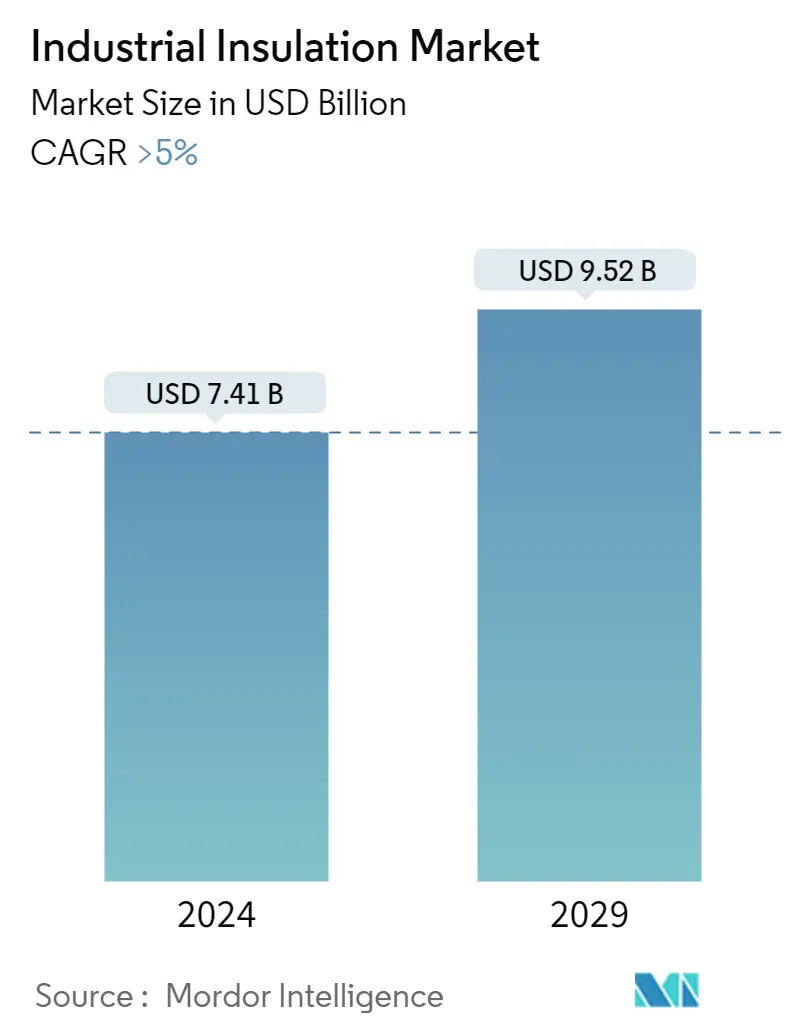
| Study Period | 2019 - 2029 |
| Market Size (2024) | USD 7.41 Billion |
| Market Size (2029) | USD 9.52 Billion |
| CAGR (2024 - 2029) | 5.00 % |
| Fastest Growing Market | Asia-Pacific |
| Largest Market | Asia-Pacific |
Major Players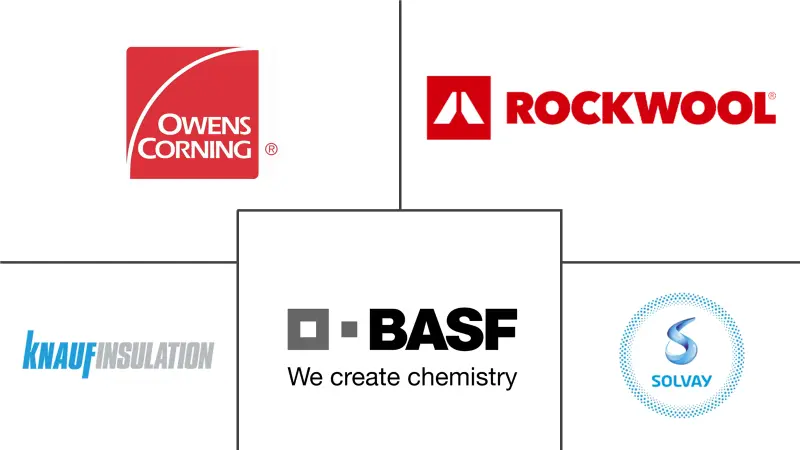
*Disclaimer: Major Players sorted in no particular order |
Industrial Insulation Market Analysis
The Industrial Insulation Market size is estimated at USD 7.41 billion in 2024, and is expected to reach USD 9.52 billion by 2029, growing at a CAGR of greater than 5% during the forecast period (2024-2029).
The COVID-19 pandemic had a big effect on the market for industrial insulation because it caused restrictions in most industries around the world. However, industries have grown faster since 2021, which has increased the need for insulation materials. Because of this, the market is likely to stay on the same path during the forecast period.
- The growing construction and power generation industries have been driving the growth of the market. Moreover, regulatory support to increase energy efficiency is also driving market growth.
- However, the health and environmental risks of insulation wool are likely to slow the growth of the market that was studied.
- The rising exploration and production activities in China, the UAE, Indonesia, and the United States and the use of organic products for insulation are likely to provide opportunities for the industrial insulation market over the upcoming years.
- The Asia-Pacific region dominates the industrial insulation market, owing to its increasing application in the construction and power generation sectors in the region.
Industrial Insulation Market Trends
Power Generation Industry to Dominate the Market
- The power generation industry stands to be the dominant segment, owing to stringent regulations mandating the use of industrial insulation to conserve energy and achieve efficiency in operations.
- In the power generation industry, industrial insulation is used to cover a variety of equipment, such as steam pipes, heat storage tanks, and boilers. Calcium silicate is one of the most common materials used to insulate power plants. It is used to insulate high-temperature pipes and equipment and for fire endurance applications.
- According to Enerdata, the total electricity generation in the world in 2022 was around 29,031 terawatt-hours, approximately 6.45% more than the previous year's electricity generation. The Asian region witnessed the highest growth in power generation followed by Middle-East and Africa.
- Since so much electricity is made every year, it is likely that the need for insulation materials will also go up a lot. One of the main applications for insulation is in power cables or transmission lines.
- According to Power Technology, the top three longest power transmission lines in the world as of 2021 were in Brazil. With a length of 2,543 kilometers, the Belo Monte-Rio de Janeiro transmission line came in first, followed by the Rio Madeira transmission link and the Belo Monte-Estreito line, respectively.
- According to the United States Department of Energy, approximately 200 miles of electrical transmission lines were covered in the United States in 2021. About 52% of the total length done that year was for projects with voltages of up to 230 kilovolts.
- Many projects are underway to lay the transmission line for the safe transmission of power from one location to another. PacifiCorp's Southeastern Idaho project, for example, scheduled to be finished in April 2022, aimed to replace outdated transmission lines with newer ones to fulfill the region's rising demand for electrical power. The project required a multi-stage electrical system upgrade from Goshen Substation near Firth, Idaho, to Rexburg Substation in Rexburg, Idaho.
- With the rising number of power plants across the globe, the demand for industrial insulation materials is also expected to gain pace during the forecast period.
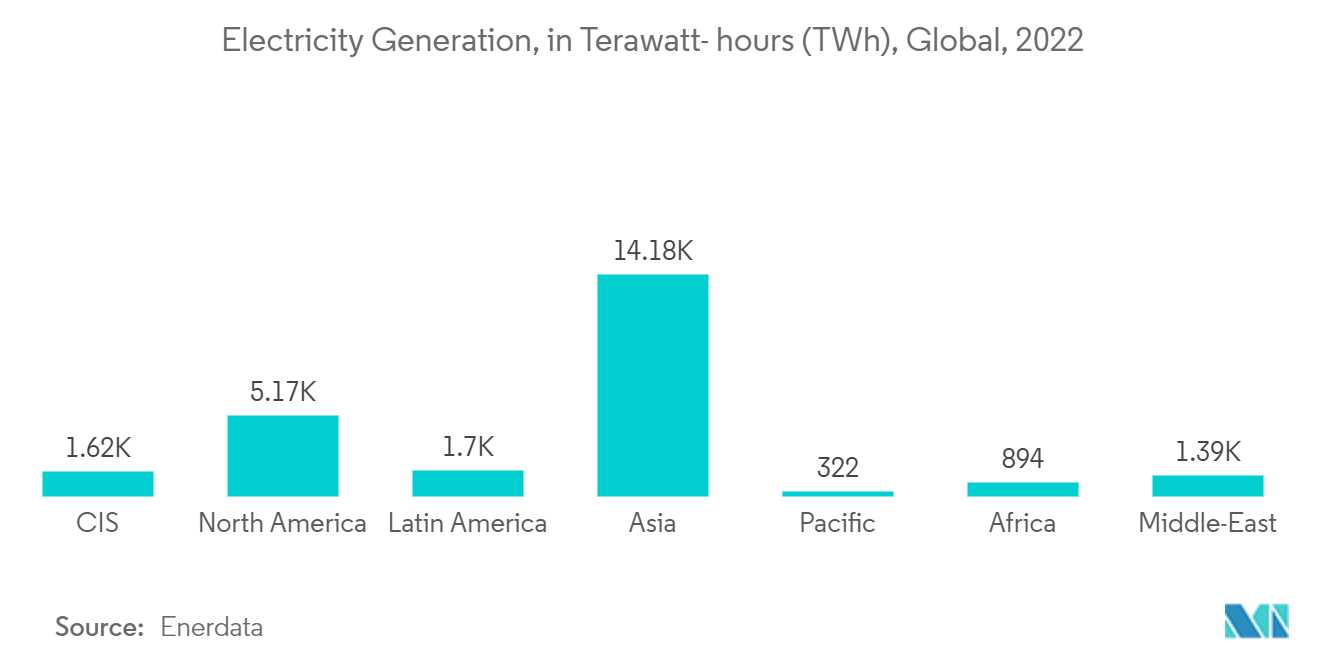
Asia-Pacific to Dominate the Market
- Asia-Pacific stands to be the largest and fastest-growing market for the construction and power generation industries. Factors, such as the increasing need for energy conservation and ensuring stringent regulatory norms by the International Green Construction Code (IGCC) standards, are driving the industry's insulation requirements in Asia-Pacific.
- According to the BP Statistical Review of World Energy 2022, the total electricity generation in the Asia-Pacific region in 2021 was close to 14,000 terawatt-hours, holding the largest share of the total electricity generated in the world. China was the largest electricity-generating country in the world with a total generation of 8,534 terawatt-hours of electricity in 2021, as stated by BP.
- As the amount of electricity made in the area went up, so did the need for power cables to insulate the electricity.As of 2021, two of China's electricity transmission lines are included in the top five longest transmission lines in the world. The first is the Jinping-Sunan transmission line, which is 2,090 km long, followed by the Xiangjiaba-Shanghai transmission line, which is about 1,980 km long.
- According to the Ministry of Power, Government of India, the country has become one of the largest synchronously interconnected electricity grids in the world with 4,63,758 circuit kilometers of transmission line and 11,56,105 MVA of transformation capacity as of January 2023.
- According to the Office of Industrial Economics (Thailand), electric wire sales in Thailand were valued at over THB 1.37 billion (~USD 42 million) as of February 2022, up from THB 1.26 billion (USD 38 million) in January 2022. Further, during the same month, the total production volume of such commodities was around 5,000 tons.
- In its report, the Ministry of Land, Infrastructure, Transport, and Tourism also said that 50 of Japan's largest builders received orders to build electric power lines worth about JPY 258.36 billion (~USD 2.35 billion) during the fiscal year 2021.
- Electric insulating materials are also essential in the electric vehicle industry. Electrical insulation is constructed of non-conductive materials and is used to control the flow of electricity and protect sensitive components.
- Insulators also protect the electric vehicle's battery management system, power electronics controllers, DC charging stations, and onboard chargers.According to the Chinese Association of Automobile Manufacturers, sales of new energy vehicles increased by 93.4% in 2022 over 2021. By the end of 2022, there would have been around 6.8 million new energy vehicle sales in China, up from only about 3.5 million sales for the entire year in 2021. Undoubtedly, the increase in EV sales and manufacturing in the nation will increase market demand.
- In the Asia-Pacific region, the market for electrical insulation material is expected to grow in the coming years because more industries are using electricity and more electronics and electrical goods are being made.
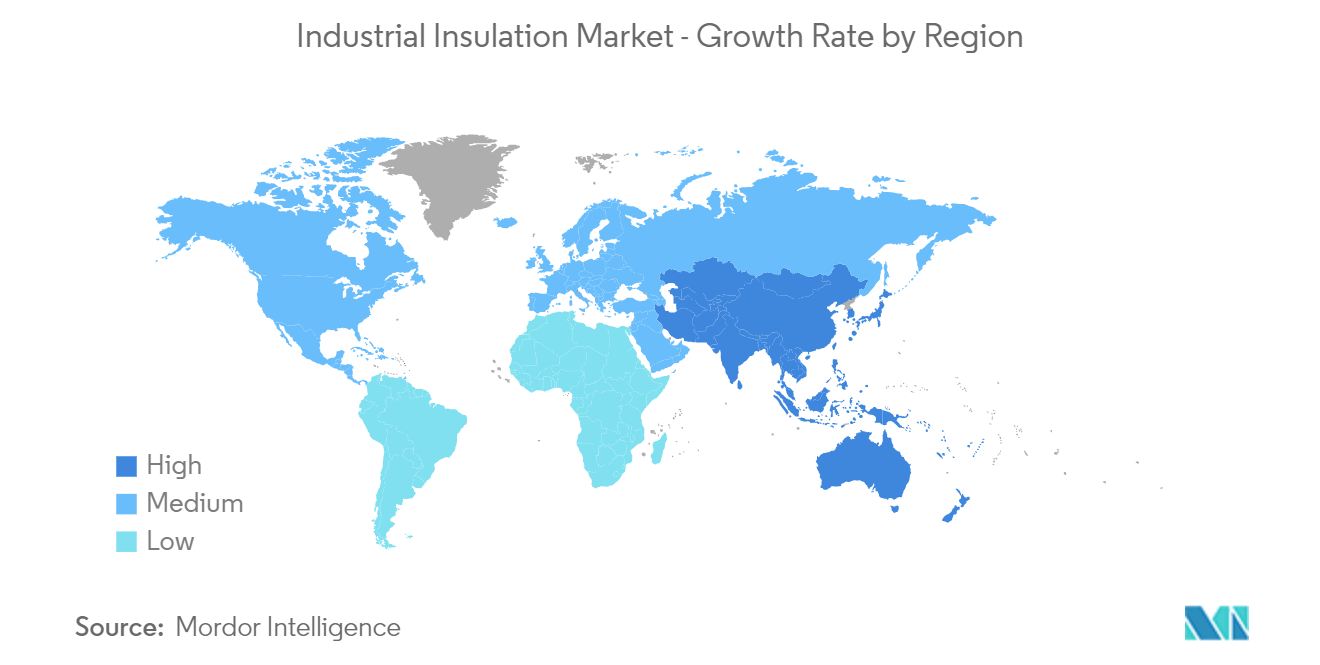
Industrial Insulation Industry Overview
The industrial insulation market is partially consolidated in nature, with a few major players dominating a significant share of the market's demand. Some of the major companies in the market (not in any particular order) include Knauf Insulation, Rockwool A/S, Owens Corning, BASF SE, and Solvay, among others.
Industrial Insulation Market Leaders
-
Knauf Insulation
-
Owens Corning
-
BASF SE
-
Solvay
-
Rockwool A/S
*Disclaimer: Major Players sorted in no particular order
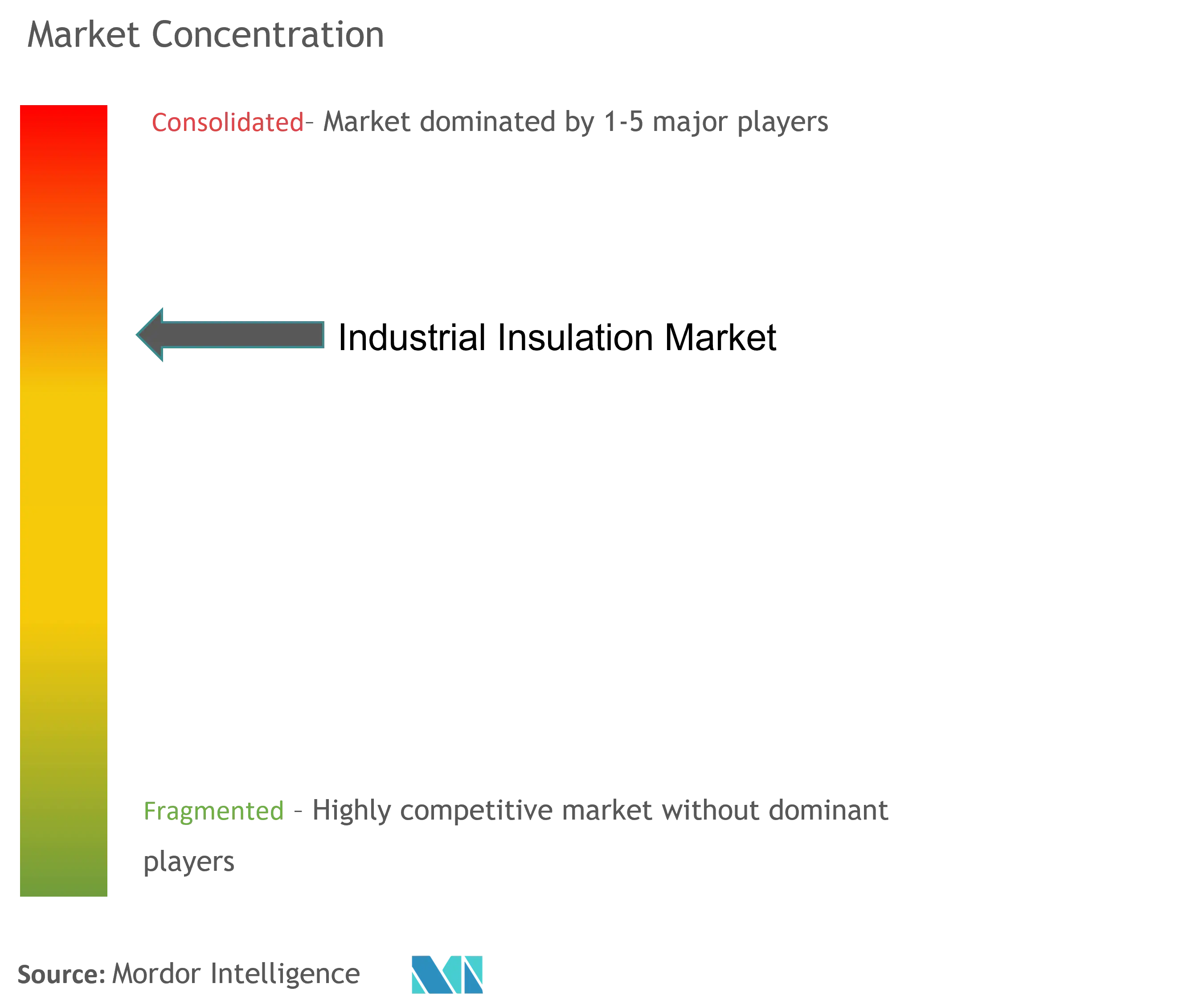
Industrial Insulation Market News
- November 2022: BEWI acquired Aislamientos y Envases SL, a Spanish insulation company that provides EPS-based products for packaging and industrial applications, to expand its geographic footprint and strengthen its insulation solutions product portfolio in Spain.
- October 2022: Knauf Group increased its mineral wool (insulation) production capacity within Central and Eastern Europe by investing close to EUR 135 million (~USD 133.4 million) in Knauf Insulation's facility in Tarnaveni, Romania, along with retrofitting the existing plant, which was acquired earlier this year. The new facility is expected to be completed by 2024.
Industrial Insulation Market Report - Table of Contents
1. INTRODUCTION
- 1.1 Study Assumptions
- 1.2 Scope of the Study
2. RESEARCH METHODOLOGY
3. EXECUTIVE SUMMARY
4. MARKET DYNAMICS
-
4.1 Drivers
- 4.1.1 Growing Construction and Power Generation Industry
- 4.1.2 Regulatory Support to Increase Energy Efficiency
-
4.2 Restraints
- 4.2.1 Environmental Hazards
- 4.2.2 Other Restraints
- 4.3 Industry Value Chain Analysis
-
4.4 Porter's Five Forces Analysis
- 4.4.1 Bargaining Power of Suppliers
- 4.4.2 Bargaining Power of Buyers
- 4.4.3 Threat of New Entrants
- 4.4.4 Threat of Substitute Products or Services
- 4.4.5 Degree of Competition
5. MARKET SEGMENTATION (Market Size in Value)
-
5.1 Insulation Material
- 5.1.1 Mineral Wool
- 5.1.2 Fiber Glass
- 5.1.3 Foamed Plastics
- 5.1.4 Calcium Silicate
- 5.1.5 Other Insulation Materials
-
5.2 Product
- 5.2.1 Blanket
- 5.2.2 Board
- 5.2.3 Pipe
- 5.2.4 Other Products
-
5.3 End-user Industry
- 5.3.1 Automotive
- 5.3.2 Chemical and Petrochemical
- 5.3.3 Construction
- 5.3.4 Electrical and Electronics
- 5.3.5 Oil and Gas
- 5.3.6 Power Generation
- 5.3.7 Other End-user Industries
-
5.4 Geography
- 5.4.1 Asia-Pacific
- 5.4.1.1 China
- 5.4.1.2 India
- 5.4.1.3 Japan
- 5.4.1.4 South Korea
- 5.4.1.5 Rest of Asia-Pacific
- 5.4.2 North America
- 5.4.2.1 United States
- 5.4.2.2 Canada
- 5.4.2.3 Mexico
- 5.4.3 Europe
- 5.4.3.1 Germany
- 5.4.3.2 United Kingdom
- 5.4.3.3 France
- 5.4.3.4 Italy
- 5.4.3.5 Rest of Europe
- 5.4.4 South America
- 5.4.4.1 Brazil
- 5.4.4.2 Argentina
- 5.4.4.3 Rest of South America
- 5.4.5 Middle East & Africa
- 5.4.5.1 Saudi Arabia
- 5.4.5.2 South Africa
- 5.4.5.3 Rest of Middle East & Africa
6. COMPETITIVE LANDSCAPE
- 6.1 Mergers and Acquisitions, Joint Ventures, Collaborations, and Agreements
- 6.2 Market Share (%) ** / Ranking Analysis
- 6.3 Strategies Adopted by Leading Players
-
6.4 Company Profiles
- 6.4.1 Armacell
- 6.4.2 BASF SE
- 6.4.3 BNZ Materials
- 6.4.4 Cabot Corporation
- 6.4.5 INSUL-FAB
- 6.4.6 Jays Refractory Specialists
- 6.4.7 Johns Manville-Berkshire Hathway Company
- 6.4.8 Knauf Insulation
- 6.4.9 Owens Corning
- 6.4.10 Rockwool A/S
- 6.4.11 Solvay
- 6.4.12 Temati Group
- *List Not Exhaustive
7. MARKET OPPORTUNITIES AND FUTURE TRENDS
- 7.1 Growing Exploration Activities in the Oil and Gas Industry
- 7.2 Use of Organic Products for Insulation
Industrial Insulation Industry Segmentation
Industrial insulation is a layer or coating of a material that is resistant to the energy being blocked. It is used all over the world in places like refineries, power plants, manufacturing facilities, and other industrial operations.
The industrial insulation market is segmented by insulation material, product, end-user industry, and geography. By insulation material, the market is segmented into mineral wool, fiberglass, foamed plastics, calcium silicate, and other insulation materials. By product, the market is segmented into blankets, boards, pipes, and other products. By end-user industry, the market is segmented into chemical and petrochemical, power generation, automotive, oil and gas, electrical and electronics, construction, and other end-user industries. The report also covers the market size and forecasts for industrial insulation in 15 countries across major regions. For each segment, market sizing and forecasts have been done on the basis of revenue (USD).
| Insulation Material | Mineral Wool | |
| Fiber Glass | ||
| Foamed Plastics | ||
| Calcium Silicate | ||
| Other Insulation Materials | ||
| Product | Blanket | |
| Board | ||
| Pipe | ||
| Other Products | ||
| End-user Industry | Automotive | |
| Chemical and Petrochemical | ||
| Construction | ||
| Electrical and Electronics | ||
| Oil and Gas | ||
| Power Generation | ||
| Other End-user Industries | ||
| Geography | Asia-Pacific | China |
| India | ||
| Japan | ||
| South Korea | ||
| Rest of Asia-Pacific | ||
| Geography | North America | United States |
| Canada | ||
| Mexico | ||
| Geography | Europe | Germany |
| United Kingdom | ||
| France | ||
| Italy | ||
| Rest of Europe | ||
| Geography | South America | Brazil |
| Argentina | ||
| Rest of South America | ||
| Geography | Middle East & Africa | Saudi Arabia |
| South Africa | ||
| Rest of Middle East & Africa |
Industrial Insulation Market Research FAQs
How big is the Industrial Insulation Market?
The Industrial Insulation Market size is expected to reach USD 7.41 billion in 2024 and grow at a CAGR of greater than 5% to reach USD 9.52 billion by 2029.
What is the current Industrial Insulation Market size?
In 2024, the Industrial Insulation Market size is expected to reach USD 7.41 billion.
Who are the key players in Industrial Insulation Market?
Knauf Insulation, Owens Corning, BASF SE, Solvay and Rockwool A/S are the major companies operating in the Industrial Insulation Market.
Which is the fastest growing region in Industrial Insulation Market?
Asia-Pacific is estimated to grow at the highest CAGR over the forecast period (2024-2029).
Which region has the biggest share in Industrial Insulation Market?
In 2024, the Asia-Pacific accounts for the largest market share in Industrial Insulation Market.
What years does this Industrial Insulation Market cover, and what was the market size in 2023?
In 2023, the Industrial Insulation Market size was estimated at USD 7.04 billion. The report covers the Industrial Insulation Market historical market size for years: 2019, 2020, 2021, 2022 and 2023. The report also forecasts the Industrial Insulation Market size for years: 2024, 2025, 2026, 2027, 2028 and 2029.
Industrial Insulation Industry Report
Statistics for the 2024 Industrial Insulation market share, size and revenue growth rate, created by Mordor Intelligence™ Industry Reports. Industrial Insulation analysis includes a market forecast outlook to 2029 and historical overview. Get a sample of this industry analysis as a free report PDF download.



